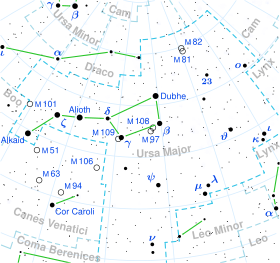Alpha Ursae majoris
| Observation data Epoch J2000 Equinox J2000 |
|
|---|---|
| Constellation | Ursa Major |
| Right ascension | 11h 03m 43.67152s |
| Declination | +61° 45′ 03.7249″ |
| Apparent magnitude (V) | 1.79 |
| Characteristics | |
| Spectral type | K0III + F0V |
| U−B color index | +0.93 |
| B−V color index | +1.07 |
| Variable type | Suspected |
| Astrometry | |
| Radial velocity (Rv) | –9 km/s |
| Proper motion (μ) |
RA: –134.11 mas/yr Dec.: –34.70 mas/yr |
| Parallax (π) | 26.54 ± 0.48mas |
| Distance | 123 ± 2 ly (37.7 ± 0.7 pc) |
| Absolute magnitude (MV) | –1.10 ± 0.04 |
| Orbit | |
| Companion | α UMa B |
| Period (P) | 44.4 yr |
| Semi-major axis (a) | 0.603" |
| Eccentricity (e) | 0.4 |
| Inclination (i) | 180° |
| Longitude of the node (Ω) | 2000° |
| Periastron epoch (T) | 1958.000 |
| Details | |
| α UMa A | |
| Mass | 4.25 M☉ |
| Luminosity | 316 L☉ |
| Surface gravity (log g) | 2.46 cgs |
| Temperature | 4,660 K |
| Metallicity [Fe/H] | –0.20 ± 0.07 dex |
| Rotational velocity (v sin i) | 2.6 ± 1.0 km/s |
| α UMa B | |
| Mass | ~1.6 M☉ |
| Other designations | |
| Database references | |
| SIMBAD | data |
Alpha Ursae Majoris (α Ursae Majoris, abbreviated Alpha UMa, α UMa), also named Dubhe, is (despite being designated 'alpha') the second-brightest star in the constellation of Ursa Major.
Alpha Ursae Majoris forms part of the Big Dipper (also known as the Plough or the Great Bear), and is the northern of the 'pointers' (or 'guards'), the two stars of Ursa Major which point towards Polaris, the North Star. Dubhe is about 123 light years from the Sun and is a giant star that has evolved away from the main sequence after consuming the hydrogen at its core. It is a spectroscopic binary with a main sequence companion α UMa B that has a stellar classification of F0V. The companion star orbits at a mean separation of about 23 astronomical units (AU) and completes an orbit every 44.4 years.
There is another spectroscopic binary 8 arc minutes distant, a 7th magnitude pair showing an F8 spectral type. It is sometimes referred to as Alpha Ursae majoris C, but is separately catalogued as HD 95638.
α Ursae Majoris has been reported to vary in brightness by about a thousandth of a magnitude. Ten radial oscillation modes have been detected, with periods between 6.4 hours and 6.4 days.
Although it is part of the constellation of Ursa Major, it does not form part of the Ursa Major Moving Group of stars that have a common motion through space.
α Ursae Majoris (Latinised to Alpha Ursae Majoris) is the star's Bayer designation.
It bore the traditional names Dubhe and Ak. Dubhe derives from the Arabic for 'bear', dubb, from the phrase ظهر الدب الاكبر żahr ad-dubb al-akbar 'the back of the Greater Bear'. The rarer Ak means 'The Eye'. In 2016, the International Astronomical Union organized a Working Group on Star Names (WGSN) to catalog and standardize proper names for stars. The WGSN's first bulletin of July 2016 included a table of the first two batches of names approved by the WGSN; which included Dubhe for this star.
...
Wikipedia

